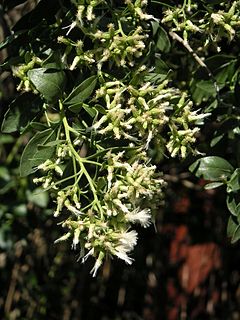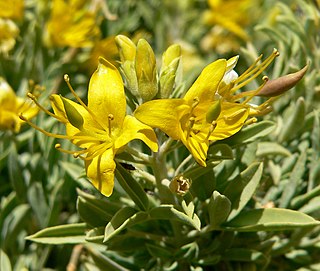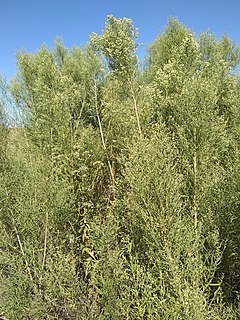
Baccharis is a genus of perennials and shrubs in the aster family (Asteraceae). They are commonly known as baccharises but sometimes referred to as "brooms", because many members have small thin leaves resembling the true brooms. They are not at all related to these however, but belong to an entirely different lineage of eudicots. B. halimifolia is commonly known as "groundsel bush", however true groundsels are found in the genus Senecio.

Baccharis pilularis, called coyote brush, chaparral broom, and bush baccharis, is a shrub in the family Asteraceae native to California, Oregon, Washington, and Baja California. There are reports of isolated populations in New Mexico, most likely introduced.

Baccharis halimifolia is a North American species of shrubs in the family Asteraceae. It is native to Nova Scotia, the eastern and southern United States, eastern Mexico, the Bahamas, and Cuba.

Baccharis sarothroides is a North American species of flowering shrub known by the common names broom baccharis, desertbroom, greasewood, rosin-bush and groundsel in English and "escoba amarga" or "romerillo" in Spanish. This is a spreading, woody shrub usually sticky with glandular secretions along the primarily leafless green stems. The small, thick leaves are a few centimeters long and are absent much of the year, giving the shrub a spindly, twiggy appearance. It flowers abundantly with tiny green blooms on separate male and female plants.

Euphorbia misera is a semi-succulent shrub in the genus Euphorbia commonly known as the cliff spurge or coast spurge. A drought-deciduous shrub, it is typically found as a gnarled, straggly plant occupying seashore bluffs, hills and deserts. Like other members of its genus, it has a milky sap, which can be found exuding out of the light gray bark when damaged. The alternately-arranged leaves are round and folded in the middle, with small hairs on them. The "flowers" can be found blooming year-round, and are colored maroon or yellow in the center with 5 white to light-yellow petal-like appendages attached outside. This species is native to the Baja California peninsula and Sonora in Mexico, and the coast of southern California in the United States, where it is a rare species. It is threatened in some localities by the development of its coastal habitat, which tends to be prime locations for high-end residential and commercial developments.

Peritoma arborea, is a perennial shrub or bush in the spiderflower family (Cleomaceae) known by the common names bladderpod, bladderpod spiderflower and burro-fat. It has yellow flowers in bloom all months of the year. It emits a foul odor to discourage herbivory from insects.

Baccharis plummerae is a California species of Baccharis known by the common name Plummer's baccharis. It is named in honor of American botanist Sara Plummer Lemmon, 1836 – 1923.

Baccharis sergiloides is a species of Baccharis known by the common name desert baccharis.

Baccharis vanessae is a rare California species of Baccharis known by the common name Encinitas baccharis. It is native primarily to San Diego County, California, almost endemic to the county except for one population a few miles over the county line in Riverside County. It is a member of the chaparral flora. It is a federally listed threatened species. It is present in several sites in Encinitas, and it is known from other parts of the county from the coastline to the mountains on various substrates. There are perhaps 15 populations remaining, for a total of about 2000 individuals. Some of the remaining occurrences are on land which may be cleared for development.

Rhamnus alnifolia is a species of flowering plant in the buckthorn family known by the common names alderleaf buckthorn, or alder buckthorn. Unlike other "buckthorns", this alder buckthorn does not have thorns. It is native to North America, where it is known mainly from the southern half of Canada and the northern half of the United States and California. It can be found in forested habitat.

Tetracoccus hallii is a species of flowering shrub in the family Picrodendraceae, known by the common names Hall's shrubby-spurge and Hall's tetracoccus.

Baccharis neglecta is a species of perennial plant in the family Asteraceae. It is native to northern Mexico and the south-western and south-central United States.
Baccharis salicina is a species of North American plants in the family Asteraceae. Common names include willow baccharis, and Great Plains false willow. It is a shrub that grows in mildly saline areas.

Greasewood is a common name shared by several plants:

Ambrosia salsola, commonly called cheesebush, winged ragweed, burrobush, white burrobrush, and desert pearl, is a species of perennial shrub in the sunflower family native to deserts of the southwestern United States and northwestern Mexico.
Baccharis bigelovii is a North American species of shrubs in the family Asteraceae known by the common name Bigelow's false willow . It is found in the Chihuahuan Desert and nearby regions of the United States and Mexico, in the States of Chihuahua, Durango, Sonora, Arizona, New Mexico, and Texas.
Baccharis havardii is a North American species of shrubs in the family Asteraceae known by the common name Havard's false willow. It is native to Chihuahua, southern New Mexico, and western Texas.
Baccharis texana is a North American species of shrubs in the family Asteraceae known by the common name prairie baccharis or false willow. It is native to northeastern Mexico and to the southern part of the Great Plains of the United States.

Baccharis wrightii is a North American species of shrubs in the family Asteraceae known by the common name Wright's baccharis or false willow. It is native to northern Mexico and the southwestern and south-central United States.

Festuca brachyphylla, commonly known as alpine fescue or short-leaved fescue, is a grass native to Eurasia, North America, and the Arctic. The grass is used for erosion control and revegetation. The specific epithet brachyphylla means "short-leaved". The grass has a diploid number of 28, 42, or 44.
















